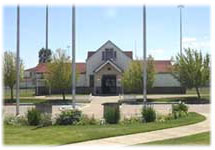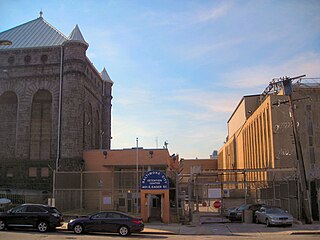
Raymondville is a city in and the county seat of Willacy County, Texas, United States. The population was 10,236 at the 2020 census. It may be included as part of the Brownsville–Harlingen–Raymondville and the Matamoros–Brownsville metropolitan areas.

CoreCivic, Inc. formerly the Corrections Corporation of America (CCA), is a company that owns and manages private prisons and detention centers and operates others on a concession basis. Co-founded in 1983 in Nashville, Tennessee, by Thomas W. Beasley, Robert Crants, and T. Don Hutto, it received investments from the Tennessee Valley Authority, Vanderbilt University, and Jack C. Massey, the founder of Hospital Corporation of America.

The GEO Group, Inc. (GEO) is a publicly traded C corporation that invests in private prisons and mental health facilities in the United States, Australia, South Africa, and the United Kingdom. Headquartered in Boca Raton, Florida, the company's facilities include immigration detention centers, minimum security detention centers, and mental-health and residential-treatment facilities. It also operates government-owned facilities pursuant to management contracts. As of December 31, 2021, the company managed and/or owned 86,000 beds at 106 facilities. In 2019, agencies of the federal government of the United States generated 53% of the company's revenues. Up until 2021 the company was designated as a real estate investment trust, at which time the board of directors elected to reclassify as a C corporation under the stated goal of reducing the company's debt.
The T. Don Hutto Residential Center is a guarded, fenced-in, multi-purpose center currently used to detain non-US citizens awaiting the outcome of their immigration status. The center is located at 1001 Welch Street in the city of Taylor, Texas, within Williamson County. Formerly a medium-security state prison, it is operated by the CoreCivic under contract with the U.S. Immigration and Customs Enforcement agency through an ICE Intergovernmental Service Agreement (IGA) with Williamson County, Texas. In 2006, Hutto became an immigrant-detention facility detaining immigrant families. The facility was turned into a women's detention center in 2009.

The Federal Correctional Institution, Sheridan is a medium-security United States federal prison for male inmates in Oregon. Opened in 1989, it is operated by the Federal Bureau of Prisons, a division of the United States Department of Justice. The facility also includes a detention center housing male offenders and an adjacent minimum-security satellite prison camp also for male offenders. FCI Sheridan is located in northwestern Oregon in Sheridan.

The United States government holds tens of thousands of immigrants in detention under the control of Customs and Border Protection and the Immigration and Customs Enforcement (ICE).
Management & Training Corporation or MTC is a contractor that manages private prisons and United States Job Corps centers, based in Centerville, Utah. MTC's core businesses are corrections, education and training, MTC medical, and economic & social development. MTC operates 21 correctional facilities in eight states. MTC also operates or partners in operating 22 of the 119 Job Corps centers across the country. They also operate in Great Britain, under the name MTCNovo.

Adelanto Detention Facility is a privately operated immigration detention center in Adelanto, San Bernardino County, California. Owned and operated by the GEO Group, it consists of two separate facilities: East, which was an existing prison purchased in June 2010 from the City of Adelanto with a capacity of about 600 inmates, and the newly built West expansion completed in August 2012 with another 700 beds. After an additional expansion in 2015, the facility's capacity houses up to 1,940 immigrant detainees of all classification levels, with an average stay of 30 days.
Reeves County Detention Complex is a privately operated immigration detention facility, located about 3 miles southwest of Pecos in Reeves County, Texas. It was opened in 1986 to relieve overcrowding of contract federal inmates within the county jails, and housed federal inmates from 1988 through 2006 through intergovernmental agreements with the Federal Bureau of Prisons.
Central Louisiana ICE Processing Center, known as CLIPC and formerly named LaSalle ICE Processing Center, is an immigration detention facility operated by the GEO Group and located at 830 Pinehill Road, about two miles northwest of downtown Jena, LaSalle Parish, Louisiana.

Baltimore City Detention Center is a Maryland Department of Public Safety and Correctional Services state prison for men and women. It is located on 401 East Eager Street in downtown Baltimore, Maryland. It has been a state facility since July 1991.
Cibola County Correctional Center is a privately owned minimum-security prison, located at 2000 Cibola Loop in Milan, Cibola County, New Mexico.
The Queens Detention Facility (QDF) is a federal prison in the Springfield Gardens neighborhood of Jamaica, Queens, New York City, and operated by the private prison company GEO Group.
The South Texas Family Residential Center is the largest immigrant detention center in the United States. Opened in December 2014 in Dilley, Texas, it has a capacity of 2,400 and is intended to detain mainly women and children from Central America.
Stewart Detention Center is a private prison operated by Corrections Corporation of America under contract with the U.S. Immigration and Customs Enforcement, primarily used for housing immigrant detainees. The facility stands in Lumpkin, Stewart County, Georgia and has an official capacity of 1752 inmates.
The Eloy Detention Center is a private prison located in Eloy, Pinal County, Arizona, owned and operated by CoreCivic, formerly the Corrections Corporation of America, under contract with the U.S. Immigration and Customs Enforcement (ICE).
Family detention is the detention of multiple family members together in an immigration detention context. In the U.S. they are referred to as family detention camps,family detention centers, or family detention facilities.

The COVID-19 pandemic has impacted prisons globally. There have been outbreaks of COVID-19 reported in prisons and jails around the world, with the housing density and population turnover of many prisons contributing to an increased risk of contracting the virus compared to the general population. Prison crowding and lack of sanitation measures contribute to the risk of contracting diseases in prisons and jails. As a mitigation measure, several jurisdictions have released prisoners to reduce density and attempt to reduce the spread of the illness. There have also been protests among prisoners, riots and prison breaks in multiple countries in response to prisoner anger over their risk of contracting illness in prison conditions. Before the COVID-19 pandemic, health services within prisons had issues providing adequate care for incarcerated people, and this has only been exacerbated by the impacts of COVID-19. Minority groups within the prison system have been disproportionately affected by the COVID-19 pandemic.
The COVID-19 pandemic in U.S. immigration detention has been covered extensively since the onset of the COVID-19 pandemic in the United States. More than 38,000 people were detained by U.S. Immigration and Customs Enforcement (ICE) at the time of the outbreak of COVID-19 in the United States. ICE's response to the outbreak in detention facilities has been widely characterized as substandard and dangerous. Harmful practices have been reported in numerous facilities managed by third-party private contractors with ICE. For example, reports found that HDQ Neutral disinfectant was used over 50 times per day in un-ventilated areas, which caused pain, bleeding, and severe illness to numerous people held in Adelanto Detention Center, a private prison managed by GEO Group Inc.
The Glades County Detention Center, at 1297 East State Road 78 in remote Moore Haven, Florida, United States, opened in 2007 with 440 beds. Operated by the Glades County Sheriff's Office, besides Glades County arrestees, 90% of its beds house Immigration and Customs Enforcement detainees, which were previously spread around many county jails. It is Glades County's largest employer. It has been the site of widespread abuses, and in 2022, 17 members of Congress asked that it be closed.








